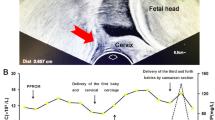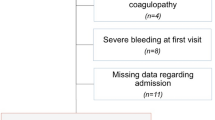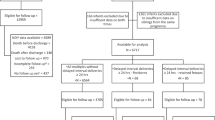Abstract
Objective
To evaluate delayed interval deliveries in multiple gestations in regard of delayed interval and neonatal survival and to provide a protocol.
Methods
Data of multiple pregnancies with delayed interval delivery at a tertiary maternity unit between 2002 and 2017 were collected. Contraindications for evaluation of a delay of the delivery of the remaining child were: severe maternal blood loss, poor maternal general condition, preeclampsia, placental abruption, fetal distress, serious congenital malformations of the remaining child, chorioamnionitis, and premature rupture of membranes of the second fetus. A total of 14 cases was included in this retrospective monocentric analysis.
Results
The cohort comprised nine twin and five triplet pregnancies. Mean gestational age at delivery of the first fetus was 21 + 6 and 26 + 0 of the retained fetus, respectively. The earliest delivery of the first fetus was at 15 + 2 weeks. The mean interval of the delay was 29.3 days (2–82 days). Mortality of the first fetuses was 53.3%, while it was 17.6% for the retained fetuses. Maternal outcome was good in general: two cases of major blood loss occurred with the necessity of a blood transfusion.
Conclusion
Delayed interval delivery is a reasonable approach in cases of an imminent preterm birth in multiple gestations which can be performed with a good fetal outcome and limited maternal risks. The situation when this procedure may be an option always comes unexpected. Therefore, the team of perinatologists should keep it in mind as one potential therapeutic approach. In addition, a standard protocol for the procedure should be established in the perinatal center.

Similar content being viewed by others
References
Pison G, D’Addato AV (2006) Frequency of twin births in developed countries. Twin Res Hum Genet 9(2):250–259. https://doi.org/10.1375/183242706776382338
Poeschmann PP, van Oppen CA, Bruinse HW (1992) Delayed interval delivery in multiple pregnancies: report of three cases and review of the literature. Obstet Gynecol Surv 47(3):139–147
Sakala EP, Branson BC (1987) Prolonged delivery-abortion interval in twin and triplet pregnancies. A report of two cases. J Reprod Med 32(1):79–81
Ziegler WF, Welgoss J (1996) Delayed delivery of a triplet pregnancy without surgical intervention: a case report. Am J Perinatol 13(3):191–193. https://doi.org/10.1055/s-2007-994323
Arabin B, van Eyck J (2009) Delayed-interval delivery in twin and triplet pregnancies: 17 years of experience in 1 perinatal center. Am J Obstet Gynecol 200(2):154.e1–154.e8. https://doi.org/10.1016/j.ajog.2008.08.046
Farkouh LJ, Sabin ED, Heyborne KD, Lindsay LG, Porreco RP (2000) Delayed-interval delivery: extended series from a single maternal-fetal medicine practice. Am J Obstet Gynecol 183(6):1499–1503. https://doi.org/10.1067/mob.2000.107319
Porreco RP, Sabin ED, Heyborne KD, Lindsay LG (1998) Delayed-interval delivery in multifetal pregnancy. Am J Obstet Gynecol 178(1 Pt 1):20–23
Roman AS, Fishman S, Fox N, Klauser C, Saltzman D, Rebarber A (2011) Maternal and neonatal outcomes after delayed-interval delivery of multifetal pregnancies. Am J Perinatol 28(2):91–96. https://doi.org/10.1055/s-0030-1262513
van Doorn HC, van Wezel-Meijler G, van Geijn HP, Dekker GA (1999) Delayed interval delivery in multiple pregnancies. Is optimism justified? Acta Obstet Gynecol Scand 78(8):710–715
Feys S, Jacquemyn Y (2016) Delayed-interval delivery can save the second twin: evidence from a systematic review. Facts Views Vis ObGyn 8(4):223–231
Fayad S, Bongain A, Holhfeld P, Janky E, Durand-Reville M, Ejnes L, Schaaps JP, Gillet JY (2003) Delayed delivery of second twin: a multicentre study of 35 cases. Eur J Obstet Gynecol Reprod Biol 109(1):16–20
Zhang J, Hamilton B, Martin J, Trumble A (2004) Delayed interval delivery and infant survival: a population-based study. Am J Obstet Gynecol 191(2):470–476. https://doi.org/10.1016/j.ajog.2004.03.002
Berghella V, Davis GH, Macones GA, Wapner RJ (1996) Prolongation of pregnancy and survival of remaining fetuses after operative evacuation of one triplet at 18 weeks’ gestation. Obstet Gynecol 88(4 Pt 2):665–666
Nagy S, Ducz R (2002) Delayed interval delivery in multiple pregnancy: case report and review of the literature. Orv Hetil 143(38):2193–2198
Reinhard J, Reichenbach L, Ernst T, Reitter A, Antwerpen I, Herrmann E, Schlosser R, Louwen F (2012) Delayed interval delivery in twin and triplet pregnancies: 6 years of experience in one perinatal center. J Perinat Med 40(5):551–555. https://doi.org/10.1515/jpm-2011-0267
Rosbergen M, Vogt HP, Baerts W, van Eyck J, Arabin B, van Nimwegen-Hamberg JM, van Lingen RA (2005) Long-term and short-term outcome after delayed-interval delivery in multi-fetal pregnancies. Eur J Obstet Gynecol Reprod Biol 122(1):66–72. https://doi.org/10.1016/j.ejogrb.2004.11.036
Omsjo IH, Alsos R (1984) Twin pregnancy: report of a case with 35 days between deliveries. Eur J Obstet Gynecol Reprod Biol 17(6):413–415
Acknowledgements
The authors thank M Etheridge, M.A. Interpreting and Translating, for professional language editing (unsalaried). This manuscript is part of the dissertation of D. Fischer.
Author information
Authors and Affiliations
Contributions
TK: project development, data collection, and manuscript writing and editing, DF: data collection and data analysis, IR: manuscript editing, MF: manuscript editing, AH: manuscript writing and editing, TMK: data collection and manuscript writing/editing, CD: project development, data collection, and data analysis, MD: data collection and data analysis, KF: project development and manuscript editing, SM: manuscript editing, UH: project development and data collection, CH: data collection, manuscript writing and editing, and project development.
Corresponding author
Ethics declarations
Conflict of interest
S Mahner has received research support, advisory board fees, honoraria, and travel support from AstraZeneca, Bayer, Boehringer Ingelheim, Jenapharm, GSK, JanssenCilag, Medac, MSD, Pharmamar, Roche, Tesaro, and Teva. All other authors declare no conflict of interest.
Research involving human participants and informed consent
For this type of study, formal consent is not required.
Rights and permissions
About this article
Cite this article
Kolben, T., Fischer, D., Ruehl, I. et al. Delayed interval delivery in multiple gestations: the Munich experience. Arch Gynecol Obstet 299, 339–344 (2019). https://doi.org/10.1007/s00404-018-4959-2
Received:
Accepted:
Published:
Issue Date:
DOI: https://doi.org/10.1007/s00404-018-4959-2




